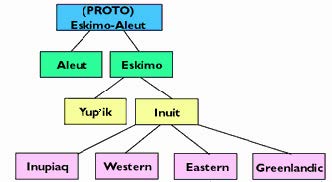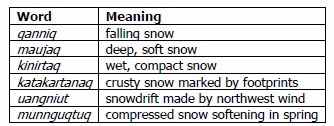INUKTITUT FACT SHEET
Are There Many People in Canada Who Speak Inuktitut?
Inuktitut means “like the Inuit,” and is spoken by approximately 29,000 people in Canada. The only Aboriginal language that is spoken by more people is Cree. For information about the Cree language, see The Cree Language fact sheet. Inuktitut is spoken in Nunavut, the Northwest Territories, along the Arctic Ocean coastline in Yukon, in the northern regions of Newfoundland and Labrador and Quebec, and in northeastern Manitoba. The following chart shows the number of Inuktitut speakers in the Inuit regions of Canada, as of 1996.
Number of Inuktitut Speakers in Various Regions of Canada
Inuktitut is recognized as an official language in Nunavut and the Northwest Territories, and also receives recognition in Nunavik (a region of Quebec) and Nunatsiavut (a region of Labrador).
Are There Different Dialects of Inuktitut?
Dialects are varieties of a language that are similar, but also have unique characteristics that develop as a result of the region in which the language is spoken. Dialects of a language may have different words, unique to their region, and they may even have different names for themselves. For example, the Inuit in the Northwest Territories may call themselves “Inuvialuit.”
Inuktitut is part of the Eskimo-Aleut language family, which is illustrated in the diagram below. There are approximately 16 dialects of Inuktitut that are spoken in Siberia, Alaska, Canada and Greenland, but it is difficult to classify distinct dialects, because Inuktitut is a language that is referred to as a linguistic chain. When dialects exist in a linguistic chain, it means that each dialect is almost identical to neighbouring dialects, but not with dialects that are spoken further away.
Eskimo-Aleut Language Family
This map shows the rough boundaries of the regions in which each dialect is spoken. It is difficult to accurately classify dialects and draw boundaries, because there are so many dialects, some with more similarities than others. Furthermore, there are some dialects that are essentially identical, though spoken in different regions.
Regions of Canada in Which Various Inuktitut Dialects Are Spoken;
https://en.wikipedia.org/wiki/File:Inuktitut_dialect_map.png
How Did the Written Inuktitut Language Develop?
The written Inuktitut language is written in Roman orthography or with Inuktitut syllabics, depending on the region and the intensity with which missionaries came to the region. Eastern Canadian dialects have 15 consonants and 3 vowels. The picture below shows the syllabary that is used to write in Inuktitut. The syllabary is based upon the Cree syllabary (for more information, see The Cree Language fact sheet), and was modified for the Inuktitut language. Many Inuktitut speakers use the Roman alphabet to write in Inuktitut.
Inuktitut Syllabics;
https://en.wikipedia.org/wiki/Inuktitut
What Are Some Places in Canada that Have Inuktitut Names?
Many of the northern communities have names that originate from the Inuktitut language. The following chart summarizes several.
Places in Canada Which Have Names of Inuit Origin;
http://www.aadnc-aandc.gc.ca/
How do the Inuit View Water?
Inuktitut has more than 200 words for snow and ice, because snow and ice have an extremely significant presence in their lives. The Inuktitut language is very specific; for example, there are different words for snow, depending on the type of snow and the surrounding conditions. The following chart summarizes several of the Inuktitut words for snow, ice, or other forms of precipitation.
Selected Inuktitut Words for Snow;
http://www.motherjones.com/environment/2005/01/dozens-words-snow-none-pollution
Unfortunately, though the Inuit have minimal contact with outsiders, they are paying a substantial price for the industrialization and pollution of the rest of North America. In Inuktitut, there is no word for pollution, chemical, or contaminant, because there has been no need for the word; most Inuit have never observed pollution, firsthand. Canadian health officials have dubbed the toxic chemicals as sukkunartuq, which means something that destroys or brings about something bad. But the use of this word has a mysterious feel to it, leaving the Inuit people feeling confused and angry.
Temperature and precipitation changes, associated with climate change, are more severe in the north, as the atmosphere carries the pollutants from the south and concentrates them in the north. The Inuit have already begun to notice changes to their environment, including changes in precipitation and water quality and availability. Drinking water sources are beginning to dry up, and those that remain are increasingly polluted. As the permafrost layer is lost, erosion causes great amounts of sediment pollution. The permafrost layer serves to protect the water and soil from mining wastes and landfills. As the layer disappears, soil and water contamination is probable. Excess nutrients are causing algae and vegetation growth. The pollution is causing the taste and odour of the water to become unpleasant and the water has a brown discolouration. Many people prefer ice water or snow water over the “swampy” taste of lakes and streams.
The occurrence of Boil Water Advisories is increasing, and many communities stock bottled water to sell to residents. As the Inuit people hear of water contamination issues from the south, they become increasingly concerned about the contaminants present in their own water. The situation in many Inuit communities is likely similar to that of First Nations communities throughout Canada; if effective water testing was done in Inuit communities, many would likely be under Boil Water Advisories.
The Safe Drinking Water Foundation has educational programs that can supplement the information found in this fact sheet. Operation Water Drop looks at the chemical contaminants that are found in water; it is designed for a science class. Operation Water Flow looks at how water is used, where it comes from and how much it costs; it has lessons that are designed for Social Studies, Math, Biology, Chemistry and Science classes. Operation Water Spirit presents a First Nations perspective of water and the surrounding issues; it is designed for Native Studies or Social Studies classes. Operation Water Health looks at common health issues surrounding drinking water in Canada and around the world and is designed for a Health, Science and Social Studies collaboration. Operation Water Pollution focuses on how water pollution occurs and how it is cleaned up and has been designed for a Science and Social Studies collaboration. To access more information on these and other educational activities, as well as additional fact sheets, visit the Safe Drinking Water Foundation website at www.safewater.org.
Did you know that our Operation Water Health and Operation Water Spirit programs are available in Cree? Several of our fact sheets are also available in Cree. Please help us to continue to offer our resources in multiple languages! Please chip in $5 or donate $20 or more and receive an Official Donation Receipt for Income Tax Purposes.
Resources:
Canadian Heritage. https://www.canada.ca/en/canadian-heritage.html
Cone, Marla. January 2005. Dozens of Words for Snow, None for Pollution.
http://www.motherjones.com/environment/2005/01/dozens-words-snow-none-pollution
Johns, Alana. 2007. Inuktitut. http://homes.chass.utoronto.ca/~ajohns/Inuktitut.html
Native Languages. 2007. Inuktitut (Eskimo/Inuit Language).
http://www.native-languages.org/inuktitut.htm







